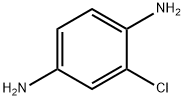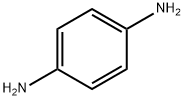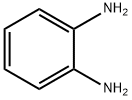2-Chloro-1,4-diaminobenzene
- CAS NO.:615-66-7
- Empirical Formula: C6H7ClN2
- Molecular Weight: 142.59
- MDL number: MFCD00128931
- EINECS: 210-441-2
- SAFETY DATA SHEET (SDS)
- Update Date: 2024-12-18 14:08:52

What is 2-Chloro-1,4-diaminobenzene?
The Uses of 2-Chloro-1,4-diaminobenzene
This compound had some uses in hair dye formulations.
Definition
ChEBI: A diamine that is 1,4-phenylenediamine substituted at position 2 by a chloro group.
Production Methods
The compound is used in hair dye formulations. 2-Chloro-p- PDA sulfate was mutagenic in the Ames test.
Flammability and Explosibility
Non flammable
Safety Profile
An experimental teratogen. Other experimental reproductive effects. An eye irritant. Decomposes explosively at 165℃/33 mbar. When heated to decomposition it emits toxic fumes of Cl and NOx. See also AROMATIC MINES.
Carcinogenicity
This compound was not carcinogenic in rats or mice in 2-year feeding studies. No new information was located.
Properties of 2-Chloro-1,4-diaminobenzene
| Melting point: | 62-66 °C |
| Boiling point: | 232.49°C (rough estimate) |
| Density | 1.2124 (rough estimate) |
| vapor pressure | 0.274Pa at 25℃ |
| refractive index | 1.5210 (estimate) |
| storage temp. | Keep in dark place,Inert atmosphere,Room temperature |
| solubility | DMSO, Methanol (Slightly) |
| form | Solid |
| pka | 4.80±0.10(Predicted) |
| color | Very Dark Green to Black |
| Water Solubility | 49.61g/L at 25℃ |
| λmax | 318nm(EtOH)(lit.) |
| CAS DataBase Reference | 615-66-7(CAS DataBase Reference) |
| EPA Substance Registry System | 1,4-Benzenediamine, 2-chloro- (615-66-7) |
Safety information for 2-Chloro-1,4-diaminobenzene
| Signal word | Warning |
| Pictogram(s) |
 Exclamation Mark Irritant GHS07 |
| GHS Hazard Statements |
H302:Acute toxicity,oral H315:Skin corrosion/irritation H319:Serious eye damage/eye irritation H332:Acute toxicity,inhalation H335:Specific target organ toxicity, single exposure;Respiratory tract irritation |
| Precautionary Statement Codes |
P261:Avoid breathing dust/fume/gas/mist/vapours/spray. P280:Wear protective gloves/protective clothing/eye protection/face protection. P305+P351+P338:IF IN EYES: Rinse cautiously with water for several minutes. Remove contact lenses, if present and easy to do. Continuerinsing. |
Computed Descriptors for 2-Chloro-1,4-diaminobenzene
2-Chloro-1,4-diaminobenzene manufacturer
Prolife Bio Chemical Industries Pvt Ltd
1Y
Phone:+919825114995
Whatsapp: +91 9825114995
product: 2-Chloro-1,4-phenylenediamine 99%
New Products
Tert-butyl bis(2-chloroethyl)carbamate (S)-3-Aminobutanenitrile hydrochloride N-Boc-D-alaninol N-BOC-D/L-ALANINOL N-octanoyl benzotriazole 4-Hydrazinobenzoic acid 3,4-Dibenzyloxybenzaldehyde 1,1’-CARBONYLDIIMIDAZOLE R-2-BENZYLOXY PROPIONIC ACID 1,1’-CARBONYLDI (1,2-4 TRIAZOLE) 4-HYDROXY BENZYL ALCOHOL 3-NITRO-2-METHYL ANILINE (2-Hydroxyphenyl)acetonitrile 4-Bromopyrazole 5-BROMO-2CYANO PYRIDINE 5,6-Dimethoxyindanone 5-broMo-2-chloro-N-cyclopentylpyriMidin-4-aMine 4-methoxy-3,5-dinitropyridine 2-(Cyanocyclohexyl)acetic acid 2-aminopropyl benzoate hydrochloride 1-(4-(aminomethyl)benzyl)urea hydrochloride tert-butyl 4- (ureidomethyl)benzylcarbamate diethyl 2-(2-((tertbutoxycarbonyl)amino) ethyl)malonate Ethyl-2-chloro((4-methoxyphenyl)hydrazono)acetateRelated products of tetrahydrofuran








You may like
-
 615‐66‐7 2 Chloro Para Phenylenediamine 98%View Details
615‐66‐7 2 Chloro Para Phenylenediamine 98%View Details
615‐66‐7 -
 615-66-7 99%View Details
615-66-7 99%View Details
615-66-7 -
 2 Chloro 1,4 Phenylene Diamine 99%View Details
2 Chloro 1,4 Phenylene Diamine 99%View Details
615-66-7 -
 2-Chloro-1,4-phenylenediamine 99%View Details
2-Chloro-1,4-phenylenediamine 99%View Details -
 2-Chloro-1,4-phenylenediamine CAS 615-66-7View Details
2-Chloro-1,4-phenylenediamine CAS 615-66-7View Details
615-66-7 -
 N-Vinylformamide 99%View Details
N-Vinylformamide 99%View Details
13162-05-5 -
 2-ethyl-6-methyl-3-hydroxypyridine succinate 99%View Details
2-ethyl-6-methyl-3-hydroxypyridine succinate 99%View Details
127464-43-1 -
 2-ETHYLPYRIDINE 100-71-0 99%View Details
2-ETHYLPYRIDINE 100-71-0 99%View Details
100-71-0
Statement: All products displayed on this website are only used for non medical purposes such as industrial applications or scientific research, and cannot be used for clinical diagnosis or treatment of humans or animals. They are not medicinal or edible.